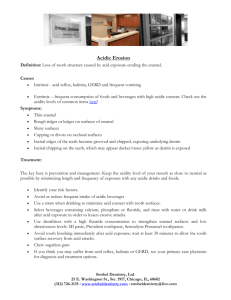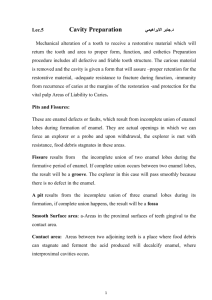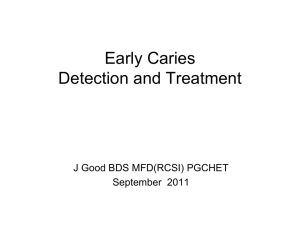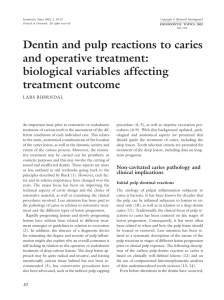Lecture 2-------------------------------
advertisement
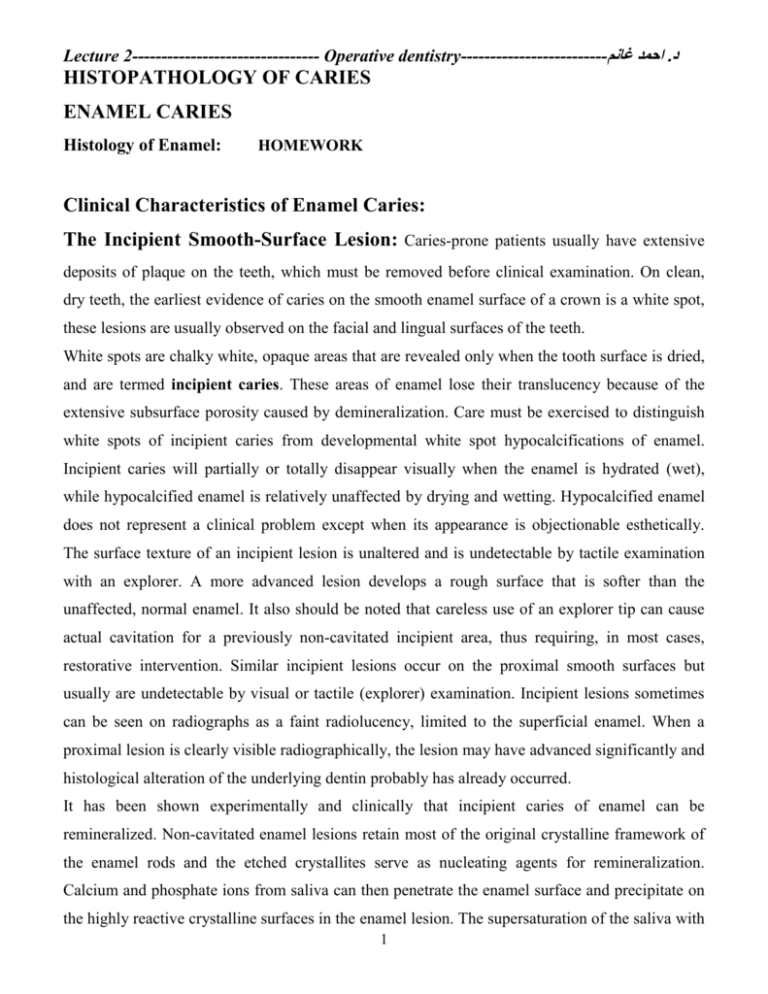
Lecture 2-------------------------------- Operative dentistry------------------------- احمد غانم.د HISTOPATHOLOGY OF CARIES ENAMEL CARIES Histology of Enamel: HOMEWORK Clinical Characteristics of Enamel Caries: The Incipient Smooth-Surface Lesion: Caries-prone patients usually have extensive deposits of plaque on the teeth, which must be removed before clinical examination. On clean, dry teeth, the earliest evidence of caries on the smooth enamel surface of a crown is a white spot, these lesions are usually observed on the facial and lingual surfaces of the teeth. White spots are chalky white, opaque areas that are revealed only when the tooth surface is dried, and are termed incipient caries. These areas of enamel lose their translucency because of the extensive subsurface porosity caused by demineralization. Care must be exercised to distinguish white spots of incipient caries from developmental white spot hypocalcifications of enamel. Incipient caries will partially or totally disappear visually when the enamel is hydrated (wet), while hypocalcified enamel is relatively unaffected by drying and wetting. Hypocalcified enamel does not represent a clinical problem except when its appearance is objectionable esthetically. The surface texture of an incipient lesion is unaltered and is undetectable by tactile examination with an explorer. A more advanced lesion develops a rough surface that is softer than the unaffected, normal enamel. It also should be noted that careless use of an explorer tip can cause actual cavitation for a previously non-cavitated incipient area, thus requiring, in most cases, restorative intervention. Similar incipient lesions occur on the proximal smooth surfaces but usually are undetectable by visual or tactile (explorer) examination. Incipient lesions sometimes can be seen on radiographs as a faint radiolucency, limited to the superficial enamel. When a proximal lesion is clearly visible radiographically, the lesion may have advanced significantly and histological alteration of the underlying dentin probably has already occurred. It has been shown experimentally and clinically that incipient caries of enamel can be remineralized. Non-cavitated enamel lesions retain most of the original crystalline framework of the enamel rods and the etched crystallites serve as nucleating agents for remineralization. Calcium and phosphate ions from saliva can then penetrate the enamel surface and precipitate on the highly reactive crystalline surfaces in the enamel lesion. The supersaturation of the saliva with 1 Lecture 2-------------------------------- Operative dentistry------------------------- احمد غانم.د calcium and phosphate ions serves as the driving force for the remineralization process. Furthermore, the presence of trace amounts of fluoride ions during this remineralization process greatly enhances the precipitation of calcium and phosphate, resulting in the remineralized enamel becoming more resistant to subsequent caries attack because of the incorporation of more acid-resistant fluorapatite. Remineralized (arrested) lesions can be observed clinically as intact, but discolored, usually brown or black spots. The change in color is presumably due to trapped organic debris and metallic ions within the enamel. These discolored, remineralized, arrested caries areas are intact and are more resistant to subsequent caries attack than the adjacent unaffected enamel. They should not be restored unless they are esthetically objectionable. Zones of Incipient Lesion: Four zones can be distinguished in these lesions which are from inside to outside: Zone 1: Translucent Zone: is the deepest zone and represents the advancing front of the enamel lesion. The name refers to its structureless appearance when treated with quinoline solution and examined with polarized light. In this zone, the pores or voids form along the enamel prism (rod) boundaries. When these boundary area voids are filled with quinoline solution, which has the same refractive index as enamel, the features of the area disappear. The pore volume of the translucent zone of enamel caries is 1%, 10 times greater than normal enamel. Zone 2: Dark Zone: is the next deepest zone, it is known as the dark zone because it does not transmit polarized light. This light blockage is caused by the presence of many tiny pores too small to absorb quinoline. These smaller air- or vapor-filled pores make the region opaque. There is theory that the dark zone is not really a stage in the sequence of the breakdown of enamel; rather, the dark zone may be formed by deposition of ions into an area previously only containing large pores. It must be remembered that caries is an episodic disease with alternating phases of demineralization and remineralization. Experimental remineralization has demonstrated increases in the size of the dark zone at the expense of the body of the lesion. There is also a loss of crystalline structure in the dark zone, suggestive of the process of demineralization and remineralization. The size of the dark zone is probably an indication of the amount of remineralization that has recently occurred. Zone 3: Body of the Lesion: The body of the lesion is the largest portion of the incipient lesion while in a demineralizing phase. It has the largest pore volume, varying from 5% at the periphery 2 Lecture 2-------------------------------- Operative dentistry------------------------- احمد غانم.د to 25% at the center. The first penetration of caries enters the enamel surface in sequence via the striae of Retzius, the interprismatic areas and the rod (prism) cores, which are then preferentially attacked. Bacteria may be present in this zone if the pore size is large enough to permit their entry Zone 4: Surface Zone: The surface zone is relatively unaffected by the caries attack. It has a lower pore volume than the body of the lesion (less than 5%) and a radiopacity comparable to unaffected adjacent enamel. The surface of normal enamel is hypermineralized by contact with saliva and has a greater concentration of fluoride ion than the immediately subjacent enamel. It has been hypothesized that hypermineralization and increased fluoride content of the superficial enamel are responsible for the relative immunity of the enamel surface. However, removal of the hypermineralized surface by polishing fails to prevent the reformation of a typical, wellmineralized surface over the carious lesion. DENTINAL CARIES Histology of Dentin: HOMEWORK Clinical and Histological Characteristics of Dentinal Caries, Acid Levels, and Reparative Responses Progression of caries in dentin is different from progression in the overlying enamel because of the structural differences of dentin. Dentin contains much less mineral and possesses microscopic 3 Lecture 2-------------------------------- Operative dentistry------------------------- احمد غانم.د tubules that provide a pathway for the ingress of acids and egress of mineral. The dentinoenamel junction has the least resistance to caries attack and allows rapid lateral spreading once caries has penetrated the enamel. Because of these characteristics, dentinal caries is V-shaped in crosssection with a wide base at the DEJ and the apex directed pulpally. Caries advances more rapidly in dentin than in enamel because dentin provides much less resistance to acid attack because of less mineralized content. Caries produces a variety of responses in dentin, including pain, demineralization, and remineralization. Often, pain is not reported even when caries invades dentin, except when deep lesions bring the bacterial infection close to the pulp. Episodes of short duration pain may be felt occasionally during earlier stages of dentin caries. These pains are due to stimulation of pulp tissue by movement of fluid through dentinal tubules that have been opened to the oral environment by cavitation. Once bacterial invasion of the dentin is close to the pulp, toxins and possibly even a few bacteria enter the pulp, resulting in inflammation of the pulpal tissues. Initial pulpal inflammation is thought to be evident clinically by production of sharp pains, with each pain lasting only a few seconds (10 or less) in response to a thermal stimulus. A short, painful response to cold suggests reversible pulpitis or pulpal hyperemia. Reversible pulpitis, as the name implies, is a limited inflammation of the pulp from which the tooth can recover if the caries producing the irritation is eliminated by timely operative treatment. When the pulp becomes more severely inflamed, a thermal stimulus will produce pain that continues after termination of the stimulus, typically longer than 10 seconds. This clinical pattern suggests irreversible pulpitis, when the pulp is unlikely to recover after removing the caries. Pulp extirpation and root canal filling usually are necessary in addition to the restorative treatment in order to save the tooth. Throbbing, continuous pain suggests partial or total pulp necrosis that is treated only by root canal therapy or extraction. Although these clinical characteristics are useful as guidelines for pulp treatment, it is emphasized that pulp symptoms can vary widely and are not always predictive of the histologic status of the tooth pulp. The pulp-dentin complex reacts to caries attacks by attempting to initiate remineralization and blocking off the open tubules. These reactions result from odontoblastic activity and the physical process of demineralization and remineralization. Three levels of dentinal reaction to caries can be recognized: (1) reaction to a long-term, low-level acid demineralization associated with a slowly advancing lesion; (2) reaction to a moderate-intensity attack; and (3) reaction to severe, rapidly advancing caries characterized by very high acid levels. 4 Lecture 2-------------------------------- Operative dentistry------------------------- احمد غانم.د The dentin can react defensively (by repair) to low- and moderate intensity caries attacks as long as the pulp remains vital and has an adequate blood circulation. The first level: In slowly advancing caries, a vital pulp can repair demineralized dentin by remineralization of the intertubular dentin and by apposition of peritubular dentin. Toxins and other metabolic by-products, especially hydrogen ion, can penetrate via the dentinal tubules to the pulp. Even when the lesion is limited to the enamel, the pulp can be shown to respond with inflammatory cells. Dentin responds to the stimulus of its first caries demineralization episode by deposition of crystalline material in both the lumen of the tubules and the intertubular dentin of affected dentin in front of the advancing infected dentin portion of the lesion. This repair only occurs if the tooth pulp is vital. Dentin that has more mineral content than normal dentin is termed sclerotic dentin. Sclerotic dentin formation occurs ahead of the demineralization front of a slowly advancing lesion and may be seen under an old restoration. Sclerotic dentin is usually shiny and more darkly colored, but feels hard to the explorer tip. By comparison, normal freshly cut dentin lacks a shiny, reflective surface and allows some penetration from a sharp explorer tip. The apparent function of sclerotic dentin is to wall off a lesion by blocking (sealing) the tubules. The permeability of sclerotic dentin is greatly reduced in comparison to normal dentin because of the decrease in the tubule lumen diameter. Therefore it may be more difficult to bond a restorative material to sclerotic dentin. The second level of dentinal response is to moderate intensity (or intermediate) irritants. More intense caries activity results in bacterial invasion of the dentin. The infected dentin contains a wide variety of pathogenic materials or irritants, including high acid levels, hydrolytic enzymes, bacteria, and bacterial cellular debris. These materials can cause the degeneration and death of the odontoblasts and their tubular extensions below the lesion, as well as a mild inflammation of the pulp. Groups of these dead, empty tubules are termed dead tracts. The pulp may be irritated sufficiently from high acid levels or bacterial enzyme production to cause the formation (from undifferentiated mesenchymal cells) of replacement odontoblasts (secondary odontoblasts). These cells produce reparative dentin (reactionary dentin) on the affected portion of the pulp chamber wall. This dentin is different from the normal dentinal apposition that occurs throughout the life of the tooth by primary (original) odontoblasts. The structure of reparative dentin can vary from 5 Lecture 2-------------------------------- Operative dentistry------------------------- احمد غانم.د well-organized tubular dentin (less often) to very irregular atubular dentin (more often), depending on the severity of the stimulus. Reparative dentin is a very effective barrier to diffusion of material through the tubules and is an important step in the repair of dentin. Severe stimuli also can result in the formation within the pulp chamber of unattached dentin, termed pulp stones, in addition to reparative dentin. The pulpal blood supply may be the most important limiting factor to the pulpal responses. The third level of dentinal response is to severe irritation. Acute, rapidly advancing caries with very high levels of acid production overpowers dentinal defenses and results in infection, abscess, and death of the pulp. In comparison to other oral tissues, the pulp is poorly tolerant of inflammation. Small, localized infections in the pulp produce an inflammatory response involving capillary dilation, local edema, and stagnation of blood flow. Because the pulp is contained in a sealed chamber and its blood is supplied through very narrow root canals, any stagnation of blood flow can result in local anoxia and necrosis. The local necrosis leads to more inflammation, edema, and stagnation of blood flow in the immediately adjacent pulp tissue, which then becomes necrotic in a cascading process that rapidly spreads to involve the entire pulp. Maintenance of pulp vitality is dependent on the adequacy of pulpal blood supply. Recently erupted teeth with large pulp chambers and short, wide canals with large apical foramina have a much more favorable prognosis for surviving pulpal inflammation than fully formed teeth with small pulp chambers and small apical foramina. 6 Lecture 2-------------------------------- Operative dentistry------------------------- احمد غانم.د 7
